Transport Simulation of Graphene Devices with a Generic Potential in the Presence of an Orthogonal Magnetic Field
Abstract
1. Introduction
2. Numerical Method
2.1. Graphene Lattice and Ribbon Geometry
2.2. Formulation of the Problem
2.3. Partition of the Graphene Structure into Slices and Solution within Each Slice
2.4. Recursive Scattering-Matrix Transport Solution
2.5. First Choice of the Magnetic Gauge and Possible Ill-Conditioning Problems
2.6. Second Choice of the Magnetic Gauge and Importance of the Choice of Contact Model
2.7. Generalization to the Case of a Space-Dependent Magnetic Field
3. Numerical Simulations
3.1. Energy-Gap Modulation
3.1.1. Simulations with Abrupt Contacts
3.1.2. Simulations without Contacts
3.1.3. Effect of Smooth Contacts
3.2. Coherent Electron Focusing
3.3. Aharonov–Bohm Interferometer
3.3.1. Simulation of a Narrow Structure
3.3.2. Simulation of a Wider Structure
4. Conclusions
Author Contributions
Funding
Institutional Review Board Statement
Informed Consent Statement
Data Availability Statement
Acknowledgments
Conflicts of Interest
References
- Castro Neto, A.H.; Guinea, F.; Peres, N.M.R.; Novoselov, K.S.; Geim, A.K. The electronic properties of graphene. Rev. Mod. Phys. 2009, 81, 109–162. [Google Scholar] [CrossRef]
- Geim, A.K.; Novoselov, K.S. The rise of graphene. Nat. Mater. 2007, 6, 183–191. [Google Scholar] [CrossRef] [PubMed]
- Novoselov, K.S.; Fal’ko, V.I.; Colombo, L.; Gellert, P.R.; Schwab, M.G.; Kim, K. A roadmap for graphene. Nature 2012, 490, 192–200. [Google Scholar] [CrossRef] [PubMed]
- Katsnelson, M.I. Graphene: Carbon in Two Dimensions; Cambridge University Press: Cambridge, UK, 2012; ISBN 978-0521195409. [Google Scholar]
- Semenoff, G.W. Condensed-Matter Simulation of a Three-Dimensional Anomaly. Phys. Rev. Lett. 1984, 53, 2449–2452. [Google Scholar] [CrossRef]
- Ando, T. Theory of Electronic States and Transport in Carbon Nanotubes. J. Phys. Soc. Jpn. 2005, 74, 777–817. [Google Scholar] [CrossRef]
- Marconcini, P.; Macucci, M. The k·p method and its application to graphene, carbon nanotubes and graphene nanoribbons: The Dirac equation. Riv. Nuovo Cimento 2011, 34, 489–584. [Google Scholar] [CrossRef]
- Katsnelson, M.I.; Novoselov, K.S.; Geim, A.K. Chiral tunnelling and the Klein paradox in graphene. Nat. Phys. 2006, 2, 620–625. [Google Scholar] [CrossRef]
- Beenakker, C.W.J. Colloquium: Andreev reflection and Klein tunneling in graphene. Rev. Mod. Phys. 2008, 80, 1337. [Google Scholar] [CrossRef]
- Katsnelson, M.I.; Novoselov, K.S. Graphene: New bridge between condensed matter physics and quantum electrodynamics. Solid State Commun. 2007, 143, 3–13. [Google Scholar] [CrossRef]
- Shytov, A.; Rudner, M.; Gu, N.; Katsnelson, M.; Levitov, L. Atomic collapse, Lorentz boosts, Klein scattering, and other quantum-relativistic phenomena in graphene. Solid State Commun. 2009, 149, 1087–1093. [Google Scholar] [CrossRef][Green Version]
- Tworzydło, J.; Trauzettel, B.; Titov, M.; Rycerz, A.; Beenakker, C.W.J. Sub-Poissonian Shot Noise in Graphene. Phys. Rev. Lett. 2006, 96, 246802. [Google Scholar] [CrossRef] [PubMed]
- Marconcini, P.; Logoteta, D.; Macucci, M. Envelope-function-based analysis of the dependence of shot noise on the gate voltage in disordered graphene samples. Phys. Rev. B 2021, 104, 155429. [Google Scholar] [CrossRef]
- Balandin, A.A. Low-frequency 1/f noise in graphene devices. Nat. Nanotechnol. 2013, 8, 549–555. [Google Scholar] [CrossRef] [PubMed]
- Pellegrini, B.; Marconcini, P.; Macucci, M.; Fiori, G.; Basso, G. Carrier density dependence of 1/f noise in graphene explained as a result of the interplay between band-structure and inhomogeneities. J. Stat. Mech. Theory Exp. 2016, 2016, 054017. [Google Scholar] [CrossRef]
- Macucci, M.; Marconcini, P. Theoretical comparison between the flicker noise behavior of graphene and of ordinary semiconductors. J. Sens. 2020, 2020, 2850268. [Google Scholar] [CrossRef]
- Ferrari, A.C.; Bonaccorso, F.; Fal’ko, V.; Novoselov, K.S.; Roche, S.; Bøggild, P.; Borini, S.; Koppens, F.H.L.; Palermo, V.; Pugno, N.; et al. Science and technology roadmap for graphene, related two-dimensional crystals, and hybrid systems. Nanoscale 2015, 7, 4598–4810. [Google Scholar] [CrossRef]
- Tiwari, S.K.; Sahoo, S.; Wang, N.; Huczko, A. Graphene research and their outputs: Status and prospect. J. Sci. Adv. Mater. Dev. 2020, 5, 10–29. [Google Scholar] [CrossRef]
- Bhimanapati, G.R.; Lin, Z.; Meunie, V.; Jung, Y.; Cha, J.; Das, S.; Xiao, D.; Son, Y.; Strano, M.S.; Cooper, V.R.; et al. Recent Advances in Two-Dimensional Materials beyond Graphene. ACS Nano 2015, 9, 11509–11539. [Google Scholar] [CrossRef]
- Khan, K.; Tareen, A.K.; Aslam, M.; Wang, R.; Zhang, Y.; Mahmood, A.; Ouyang, Z.; Zhang, H.; Guo, Z. Recent developments in emerging two-dimensional materials and their applications. J. Mater. Chem. C 2020, 8, 387–440. [Google Scholar] [CrossRef]
- Jiang, L.; Marconcini, P.; Hossian, M.S.; Qiu, W.; Evans, R.J.; Macucci, M.; Skafidas, S. A tight binding and k·p study of monolayer stanene. Sci. Rep. 2017, 7, 12069. [Google Scholar] [CrossRef]
- Brey, L.; Fertig, H.A. Electronic states of graphene nanoribbons studied with the Dirac equation. Phys. Rev. B 2006, 73, 235411. [Google Scholar] [CrossRef]
- Son, Y.W.; Cohen, M.L.; Louie, S.G. Energy Gaps in Graphene Nanoribbons. Phys. Rev. Lett. 2006, 97, 216803. [Google Scholar] [CrossRef] [PubMed]
- Marconcini, P.; Cresti, A.; Roche, S. Effect of the Channel Length on the Transport Characteristics of Transistors Based on Boron-Doped Graphene Ribbons. Materials 2018, 11, 667. [Google Scholar] [CrossRef] [PubMed]
- Fürst, J.A.; Pedersen, J.G.; Flindt, C.; Mortensen, N.A.; Brandbyge, M.; Pedersen, T.G.; Jauho, A.-P. Electronic properties of graphene antidot lattices. New J. Phys. 2009, 11, 095020. [Google Scholar] [CrossRef]
- Marconcini, P.; Macucci, M. Envelope-function based transport simulation of a graphene ribbon with an antidot lattice. IEEE Trans. Nanotechnol. 2017, 16, 534–544. [Google Scholar] [CrossRef]
- Schwierz, F. Graphene Transistors. Nat. Nanotechnol. 2010, 5, 487–496. [Google Scholar] [CrossRef]
- Schwierz, F. Graphene Transistors: Status, Prospects, and Problems. Proc. IEEE 2013, 101, 1567–1584. [Google Scholar] [CrossRef]
- Avouris, P.; Xia, F. Graphene applications in electronics and photonics. MRS Bull. 2012, 37, 1225–1234. [Google Scholar] [CrossRef]
- Mreńca-Kolasińska, A.; Heun, S.; Szafran, B. Aharonov-Bohm interferometer based on n–p junctions in graphene nanoribbons. Phys. Rev. B 2016, 93, 125411. [Google Scholar] [CrossRef]
- Novoselov, K.S.; Geim, A.K.; Morozov, S.V.; Jiang, D.; Katsnelson, M.I.; Grigorieva, I.V.; Dubonos, S.V.; Firsov, A.A. Two-dimensional gas of massless Dirac fermions in graphene. Nature 2005, 438, 197–200. [Google Scholar] [CrossRef]
- Zhang, Y.; Tan, Y.-W.; Stormer, H.L.; Kim, P. Experimental observation of the quantum Hall effect and Berry’s phase in graphene. Nature 2005, 438, 201–204. [Google Scholar] [CrossRef] [PubMed]
- Haldane, F.D.M. Model for a Quantum Hall Effect without Landau Levels: Condensed-Matter Realization of the “Parity Anomaly”. Phys. Rev. Lett. 1988, 61, 2015–2018. [Google Scholar] [CrossRef] [PubMed]
- Zheng, Y.; Ando, T. Hall conductivity of a two-dimensional graphite system. Phys. Rev. B 2002, 65, 245420. [Google Scholar] [CrossRef]
- Gusynin, V.P.; Sharapov, S.G. Unconventional Integer Quantum Hall Effect in Graphene. Phys. Rev. Lett. 2005, 95, 146801. [Google Scholar] [CrossRef] [PubMed]
- Brey, L.; Fertig, H.A. Edge states and the quantized Hall effect in graphene. Phys. Rev. B 2006, 73, 195408. [Google Scholar] [CrossRef]
- Novoselov, K.S.; McCann, E.; Morozov, S.V.; Fal’ko, V.I.; Katsnelson, M.I.; Zeitler, U.; Jiang, D.; Schedin, F.; Geim, A.K. Unconventional quantum Hall effect and Berry’s phase of 2π in bilayer graphene. Nat. Phys. 2006, 2, 177–180. [Google Scholar] [CrossRef]
- Rickhaus, P.; Makk, P.; Liu, M.-H.; Tóvári, E.; Weiss, M.; Maurand, R.; Richter, K.; Schönenberger, C. Snake trajectories in ultraclean graphene p–n junctions. Nat. Commun. 2015, 6, 6470. [Google Scholar] [CrossRef]
- Peierls, R. Zur Theorie des Diamagnetismus von Leitungselektronen. Z. Phys. 1933, 80, 763–791. [Google Scholar] [CrossRef]
- Wakabayashi, K.; Fujita, M.; Ajiki, H.; Sigrist, M. Electronic and magnetic properties of nanographite ribbons. Phys. Rev. B 1999, 59, 8271. [Google Scholar] [CrossRef]
- Peres, N.M.R.; Castro Neto, A.H.; Guinea, F. Conductance quantization in mesoscopic graphene. Phys. Rev. B 2006, 73, 195411. [Google Scholar] [CrossRef]
- Peres, N.M.R.; Castro Neto, A.H. and; Guinea, F. Dirac fermion confinement in graphene. Phys. Rev. B 2006, 73, 241403. [Google Scholar] [CrossRef]
- Stegmann, T.; Lorke, A. Edge magnetotransport in graphene: A combined analytical and numerical study. Ann. Phys. 2015, 527, 723–736. [Google Scholar] [CrossRef]
- Logoteta, D.; Marconcini, P.; Bonati, C.; Fagotti, M.; Macucci, M. High-performance solution of the transport problem in a graphene armchair structure with a generic potential. Phys. Rev. E 2014, 89, 063309. [Google Scholar] [CrossRef] [PubMed]
- Marconcini, P.; Macucci, M. Geometry-dependent conductance and noise behavior of a graphene ribbon with a series of randomly spaced potential barriers. J. Appl. Phys. 2019, 125, 244302. [Google Scholar] [CrossRef]
- Fagotti, M.; Bonati, C.; Logoteta, D.; Marconcini, P.; Macucci, M. Armchair graphene nanoribbons: PT-symmetry breaking and exceptional points without dissipation. Phys. Rev. B 2011, 83, 241406. [Google Scholar] [CrossRef]
- Macucci, M.; Marconcini, P.; Roche, S. Optimization of the Sensitivity of a Double-Dot Magnetic Detector. Electronics 2020, 9, 1134. [Google Scholar] [CrossRef]
- Rothe, H.J. Lattice Gauge Theories: An Introduction; World Scientific Lecture Notes in Physics; World Scientific Publishing: Singapore, 2005; Volume 74, ISBN 981-256-062-9. [Google Scholar]
- Stacey, R. Eliminating lattice fermion doubling. Phys. Rev. D 1982, 26, 468–472. [Google Scholar] [CrossRef]
- Tworzydło, J.; Groth, C.W.; Beenakker, C.W.J. Finite difference method for transport properties of massless Dirac fermions. Phys. Rev. B 2008, 78, 235438. [Google Scholar] [CrossRef]
- Wurm, J.; Wimmer, M.; Adagideli, Ì.; Richter, K.; Baranger, H.U. Interfaces within graphene nanoribbons. New J. Phys. 2009, 11, 095022. [Google Scholar] [CrossRef]
- Datta, S. Electronic Transport in Mesoscopic Systems; Cambridge University Press: Cambridge, UK, 1997; ISBN 978-0521599436. [Google Scholar]
- Landauer, R. Spatial Variation of Currents and Fields Due to Localized Scatterers in Metallic Conduction. IBM J. Res. Dev. 1957, 1, 223–231. [Google Scholar] [CrossRef]
- Büttiker, M.; Imry, Y.; Landauer, R.; Pinhas, S. Generalized many-channel conductance formula with application to small rings. Phys. Rev. B 1985, 31, 6207. [Google Scholar] [CrossRef] [PubMed]
- Wakamatsu, M.; Kitadono, Y.; Zhang, P.-M. The issue of gauge choice in the Landau problem and the physics of canonical and mechanical orbital angular momenta. Ann. Phys. 2018, 392, 287–322. [Google Scholar] [CrossRef]
- Golub, G.H.; Van Loan, C.F. Matrix Computations; Johns Hopkins University Press: Baltimore, MD, USA, 2013; ISBN 978-1421407944. [Google Scholar]
- Anderson, E.; Bai, Z.; Bischof, C.; Blackford, L.S.; Demmel, J.; Dongarra, J.; Du Croz, J.; Greenbaum, A.; Hammarling, S.; McKenney, A.; et al. LAPACK Users’ Guide; Society for Industrial and Applied Mathematics: Philadelphia, PA, USA, 1999; ISBN 978-0-89871-447-0. [Google Scholar] [CrossRef]
- Lehoucq, R.B.; Sorensen, D.C.; C. Yang, C. ARPACK Users’ Guide: Solution of Large-Scale Eigenvalue Problems with Implicitly Restarted Arnoldi Methods; Society for Industrial and Applied Mathematics: Philadelphia, PA, USA, 1998; ISBN 978-0-89871-407-4. [Google Scholar] [CrossRef]
- Fokkema, D.R.; Sleijpen, G.L.G.; Van der Vorst, H.A. Jacobi-Davidson Style QR and QZ Algorithms for the Reduction of Matrix Pencils. SIAM J. Sci. Comput. 1998, 20, 94–125. [Google Scholar] [CrossRef]
- Bar-On, I.; Ryaboy, V. Fast Diagonalization of Large and Dense Complex Symmetric Matrices, with Applications to Quantum Reaction Dynamics. SIAM J. Sci. Comput. 1997, 18, 1412–1435. [Google Scholar] [CrossRef]
- Bar-On, I.; Paprzycki, M. High performance solution of the complex symmetric eigenproblem. Numer. Algorithms 1998, 18, 195–208. [Google Scholar] [CrossRef]
- Polizzi, E. Density-Matrix-Based Algorithms for Solving Eigenvalue Problems. Phys. Rev. B. 2009, 79, 115112. [Google Scholar] [CrossRef]
- Büttiker, M.; Christen, T. Basic Elements of Electrical Conduction. In Quantum Transport in Semiconductor Submicron Structures; Nato Science Series E; Kramer, B., Ed.; Kluwer Academic Publishers: Dordrecht, NL, USA, 2011; Volume 326, pp. 263–291. ISBN 978-9401072878. [Google Scholar]
- Khomyakov, P.A.; Giovannetti, G.; Rusu, P.C.; Brocks, G.; van den Brink, J.; Kelly, P.J. First-principles study of the interaction and charge transfer between graphene and metals. Phys. Rev. B 2009, 79, 195425. [Google Scholar] [CrossRef]
- Giubileo, F.; Di Bartolomeo, A. The role of contact resistance in graphene field-effect devices. Prog. Surf. Sci. 2017, 92, 143–175. [Google Scholar] [CrossRef]
- Bala Kumar, S.; Jalil, M.B.A.; Tan, S.G.; Liang, L. Magnetoresistive effect in graphene nanoribbon due to magnetic field induced band gap modulation. J. Appl. Phys. 2010, 108, 033709. [Google Scholar] [CrossRef]
- Bala Kumar, S.; Guo, J. Modelling very large magnetoresistance of graphenenanoribbon devices. Nanoscale 2012, 4, 982–985. [Google Scholar] [CrossRef]
- Huang, Y.C.; Chang, C.P.; Lin, M.F. Magnetic and quantum confinement effects on electronic and optical properties of graphene ribbons. Nanotechnology 2007, 18, 495401. [Google Scholar] [CrossRef] [PubMed]
- Ritter, C.; Makler, S.S.; Latg’e, A. Energy-gap modulations of graphene ribbons under external fields: A theoretical study. Phys. Rev. B 2008, 77, 195443. [Google Scholar] [CrossRef]
- Bai, J.; Cheng, R.; Xiu, F.; Liao, L.; Wang, M.; Shailos, A.; Wang, K.L.; Huang, Y.; Duan, X. Very large magnetoresistance in graphene nanoribbons. Nat. Nanotechnol. 2010, 5, 655–659. [Google Scholar] [CrossRef] [PubMed]
- Rakyta, P.; Kormányos, A.; Cserti, J.; Koskinen, P. Exploring the graphene edges with coherent electron focusing. Phys. Rev. B 2010, 81, 115411. [Google Scholar] [CrossRef]
- Stegmann, T.; Wolf, D.E.; Lorke, A. Magnetotransport along a boundary: From coherent electron focusing to edge channel transport. New J. Phys. 2013, 15, 113047. [Google Scholar] [CrossRef][Green Version]
- Taychatanapat, T.; Watanabe, K.; Taniguchi, T.; Jarillo-Herrero, P. Electrically tunable transverse magnetic focusing in graphene. Nat. Phys. 2013, 9, 225–229. [Google Scholar] [CrossRef]
- Morikawa, S.; Dou, Z.; Wang, S.-W.; Smith, C.G.; Watanabe, K.; Taniguchi, T.; Masubuchi, S.; Machida, T.; Connolly, M.R. Imaging ballistic carrier trajectories in graphene using scanning gate microscopy. Appl. Phys. Lett. 2015, 107, 243102. [Google Scholar] [CrossRef]
- Bhandari, S.; Lee, G.H.; Klales, A.; Watanabe, K.; Taniguchi, T.; Heller, E.; Kim, P.; Westervelt, R.W. Imaging Cyclotron Orbits of Electrons in Graphene. Nano Lett. 2016, 16, 1690–1694. [Google Scholar] [CrossRef] [PubMed]
- Marconcini, P.; Macucci, M. Effects of A Magnetic Field on the Transport and Noise Properties of a Graphene Ribbon with Antidots. Nanomaterials 2020, 10, 2098. [Google Scholar] [CrossRef]
- Mreńca-Kolasińska, A.; Szafran, B. Lorentz force effects for graphene Aharonov-Bohm interferometers. Phys. Rev. B 2016, 94, 195315. [Google Scholar] [CrossRef]
- Tworzydło, J.; Snyman, I.; Akhmerov, A.R.; Beenakker, C.W.J. Valley-isospin dependence of the quantum Hall effect in a graphene p–n junction. Phys. Rev. B 2007, 76, 035411. [Google Scholar] [CrossRef]

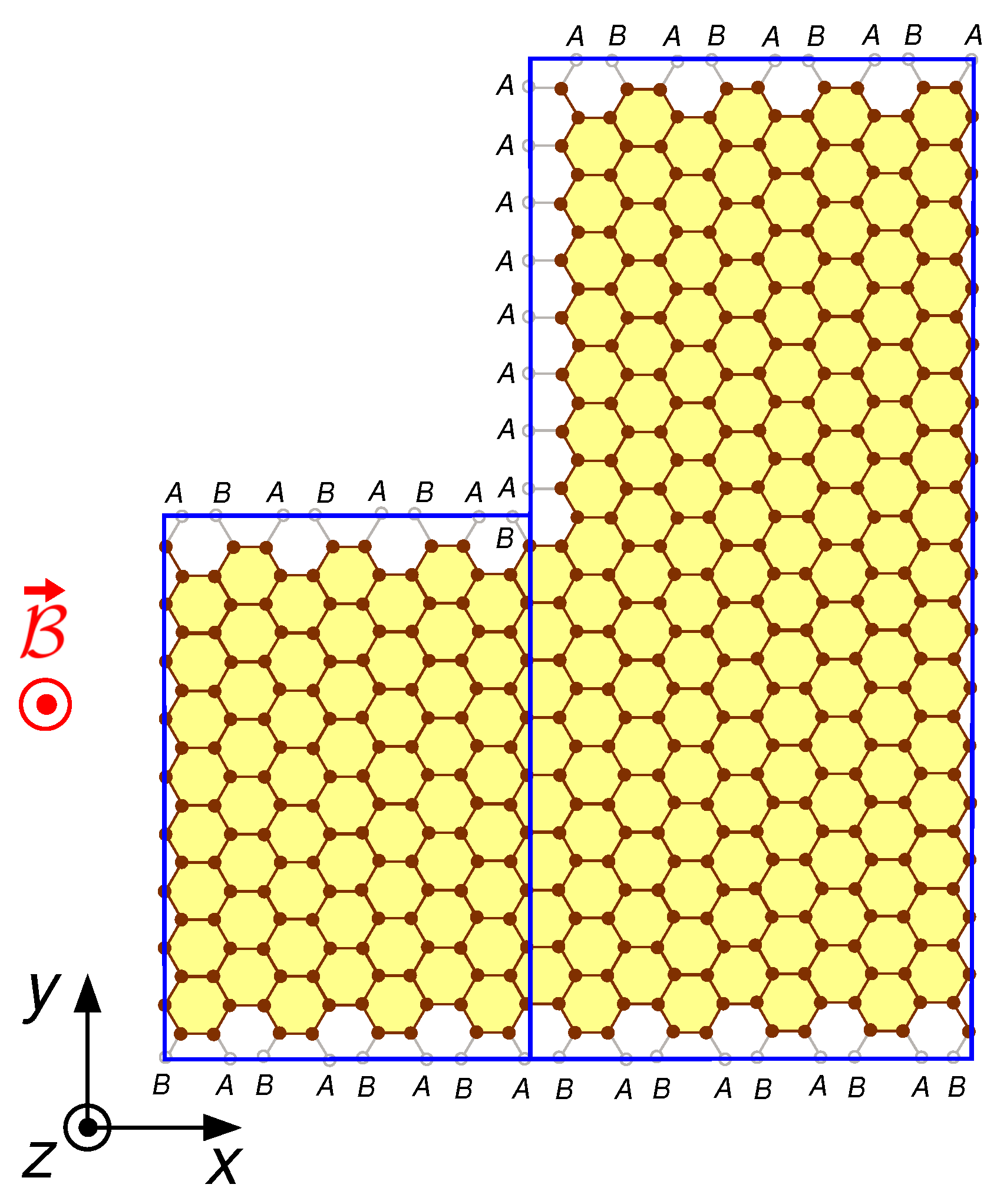


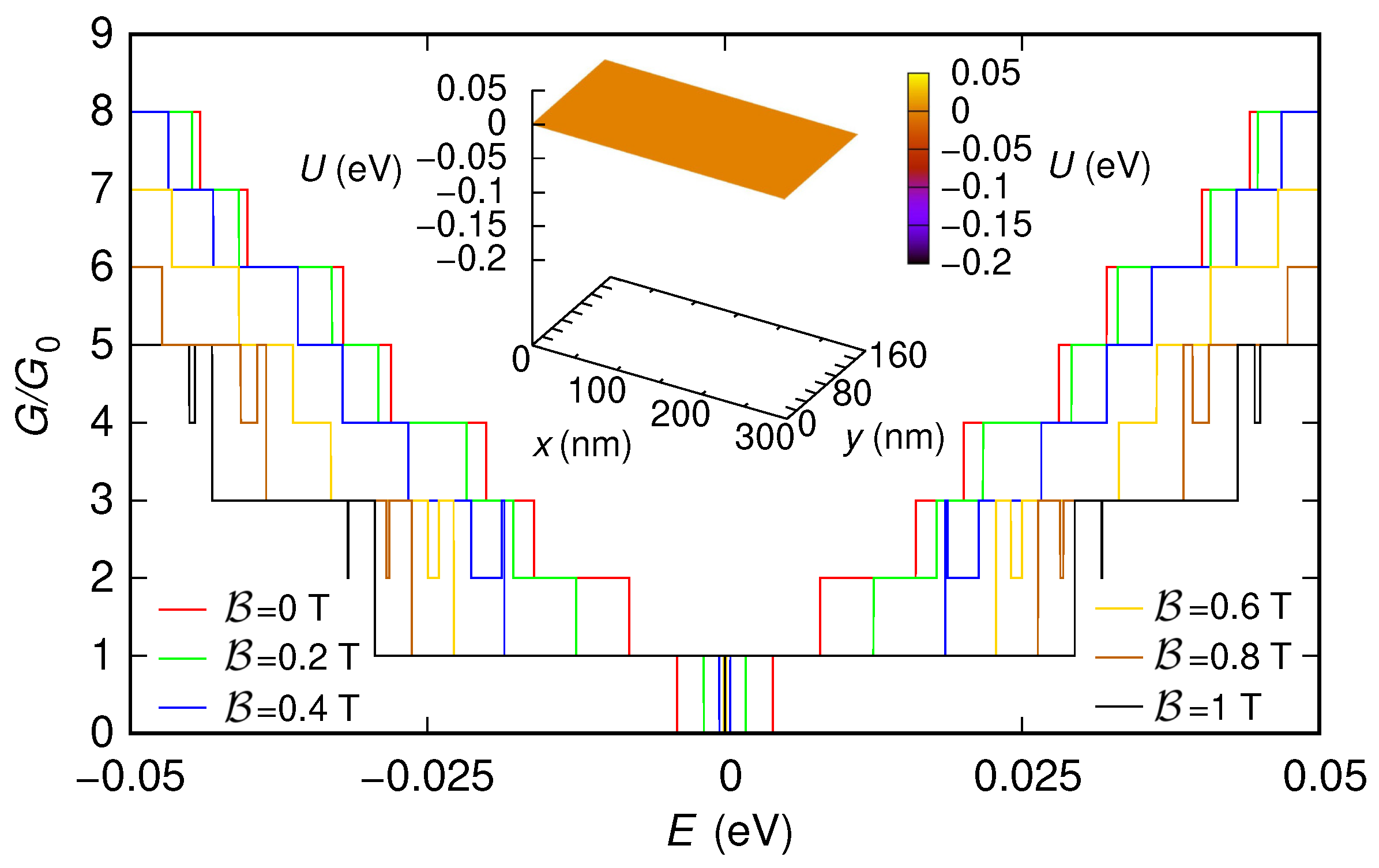

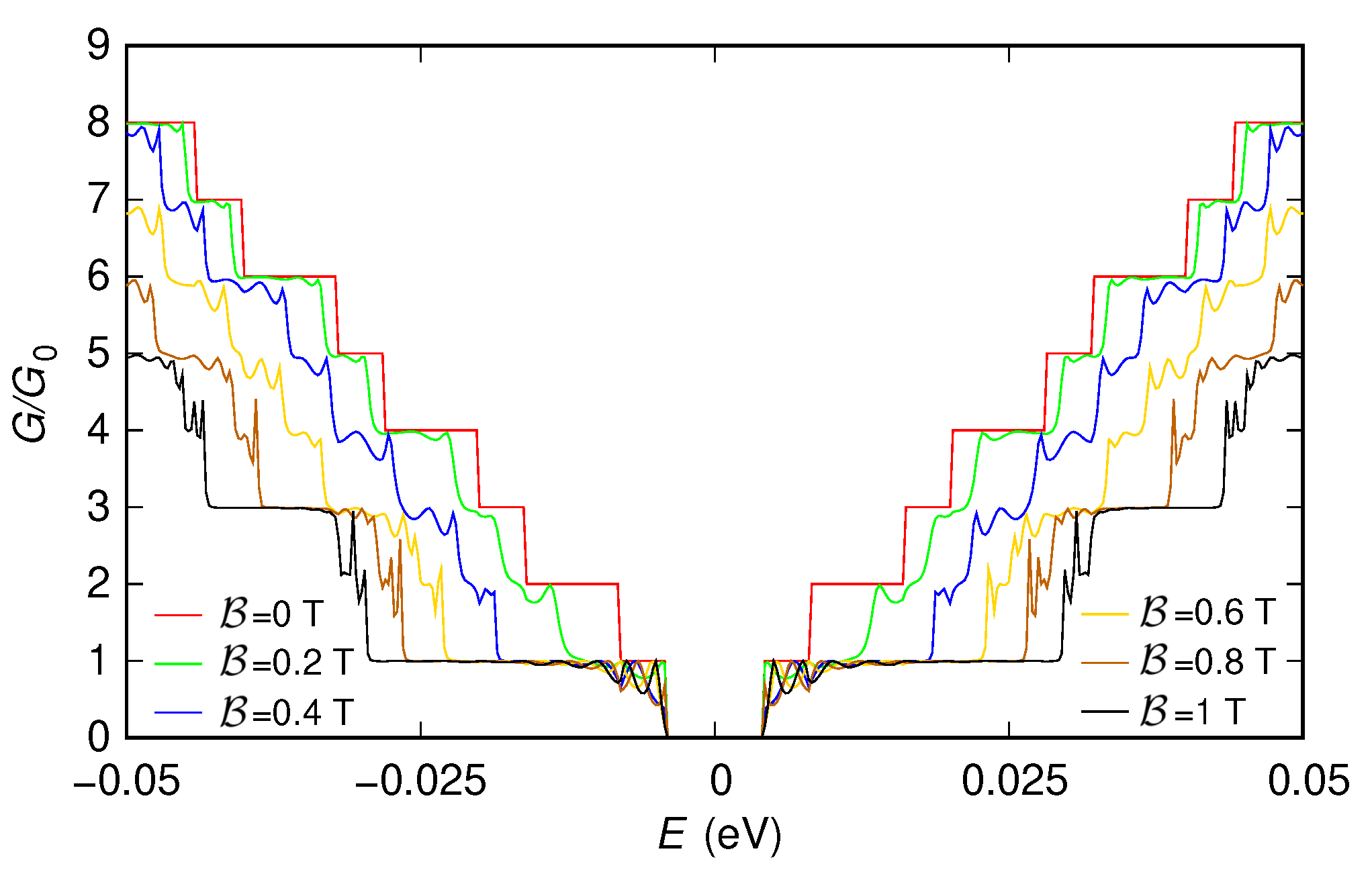
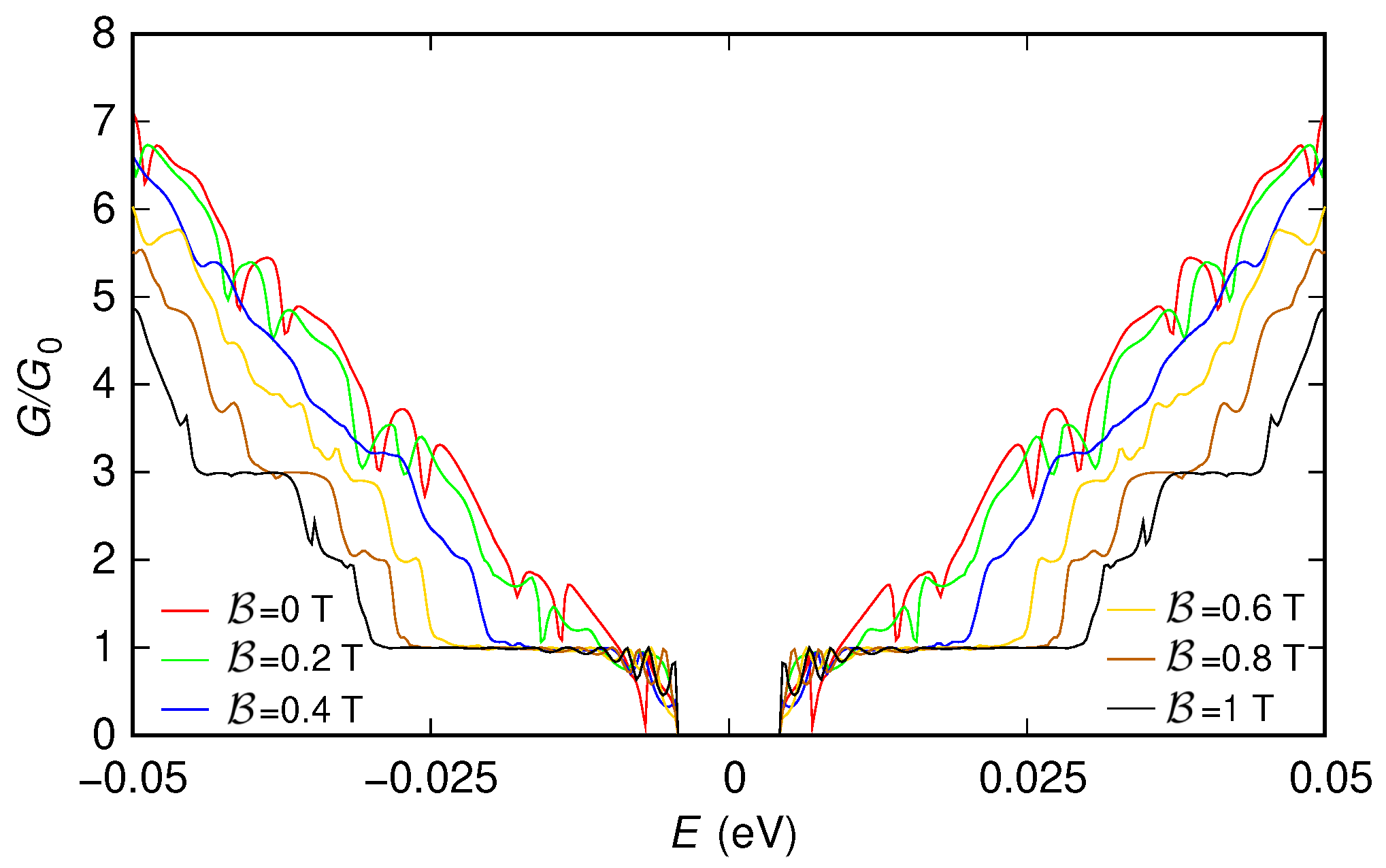
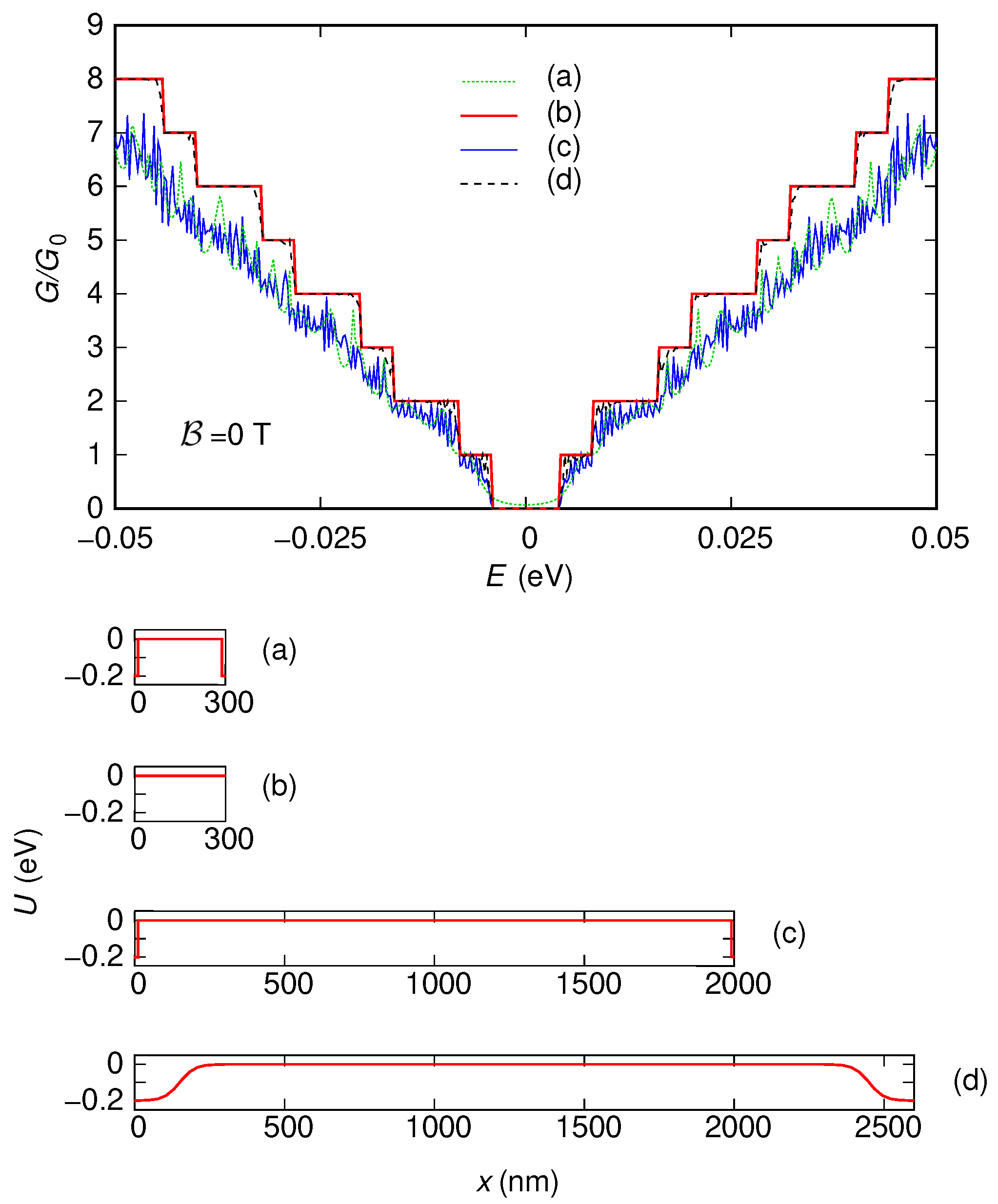
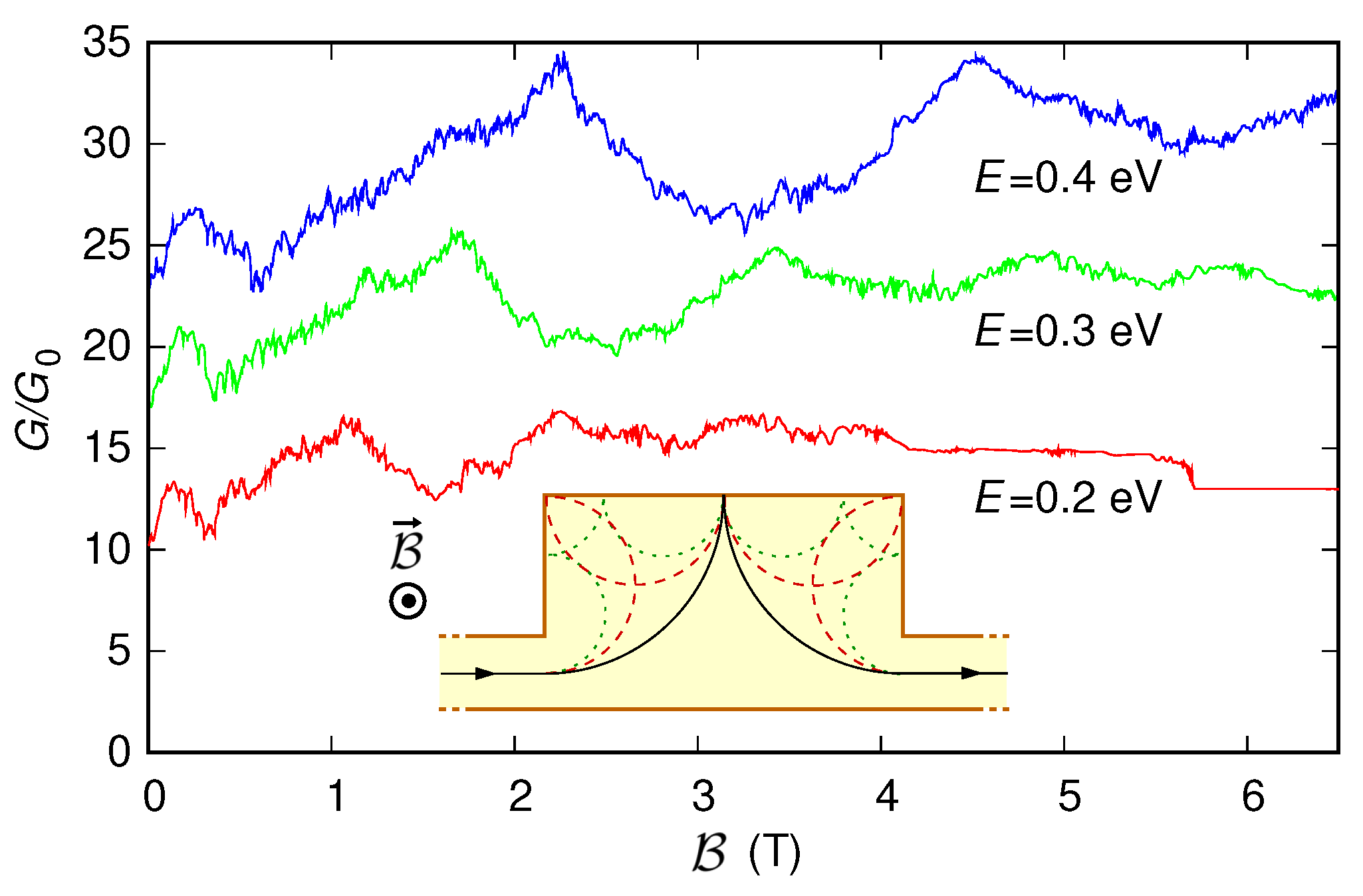

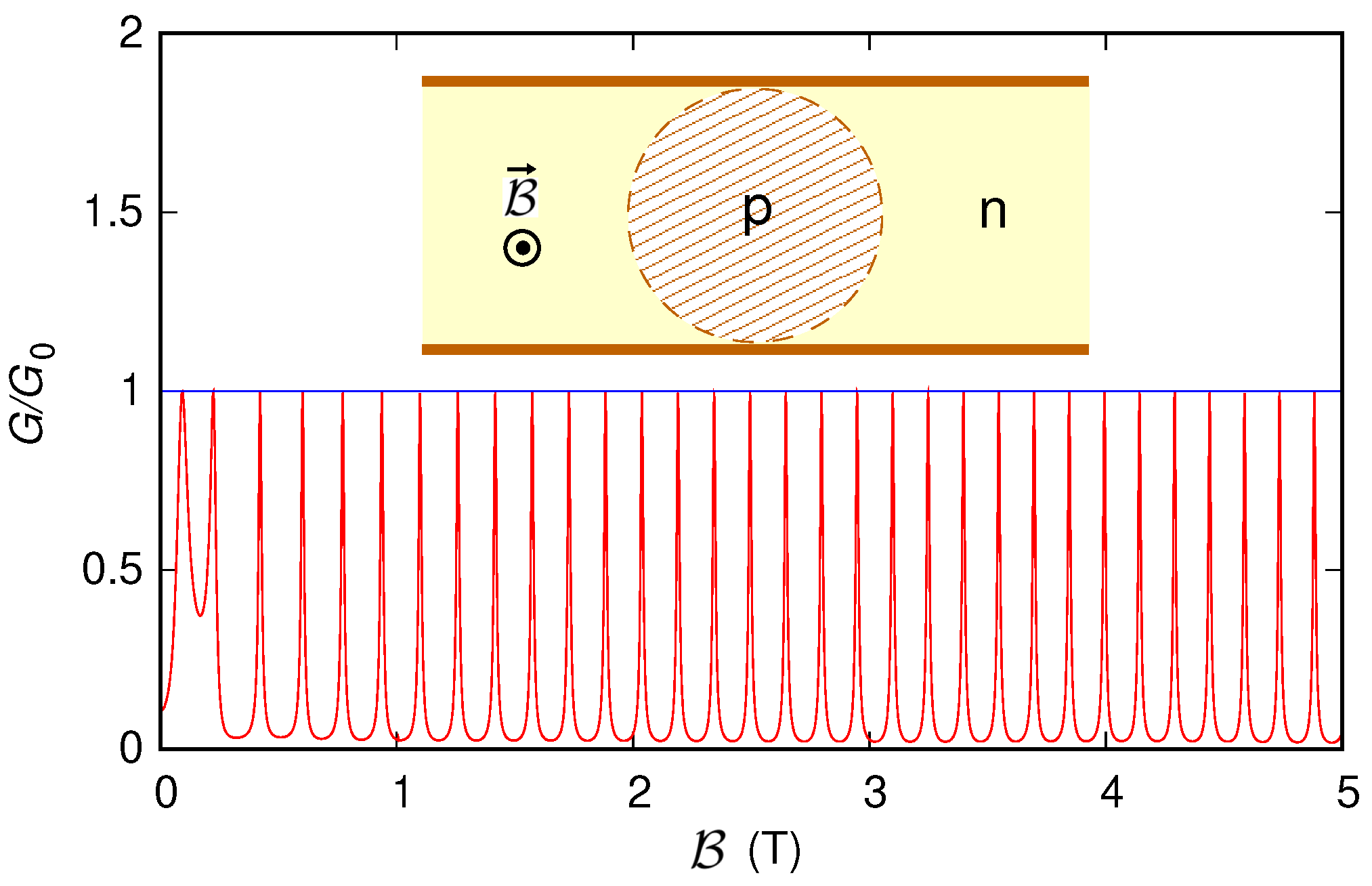
Publisher’s Note: MDPI stays neutral with regard to jurisdictional claims in published maps and institutional affiliations. |
© 2022 by the authors. Licensee MDPI, Basel, Switzerland. This article is an open access article distributed under the terms and conditions of the Creative Commons Attribution (CC BY) license (https://creativecommons.org/licenses/by/4.0/).
Share and Cite
Marconcini, P.; Macucci, M. Transport Simulation of Graphene Devices with a Generic Potential in the Presence of an Orthogonal Magnetic Field. Nanomaterials 2022, 12, 1087. https://doi.org/10.3390/nano12071087
Marconcini P, Macucci M. Transport Simulation of Graphene Devices with a Generic Potential in the Presence of an Orthogonal Magnetic Field. Nanomaterials. 2022; 12(7):1087. https://doi.org/10.3390/nano12071087
Chicago/Turabian StyleMarconcini, Paolo, and Massimo Macucci. 2022. "Transport Simulation of Graphene Devices with a Generic Potential in the Presence of an Orthogonal Magnetic Field" Nanomaterials 12, no. 7: 1087. https://doi.org/10.3390/nano12071087
APA StyleMarconcini, P., & Macucci, M. (2022). Transport Simulation of Graphene Devices with a Generic Potential in the Presence of an Orthogonal Magnetic Field. Nanomaterials, 12(7), 1087. https://doi.org/10.3390/nano12071087







